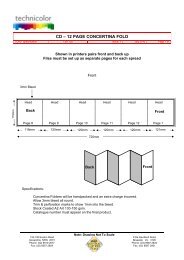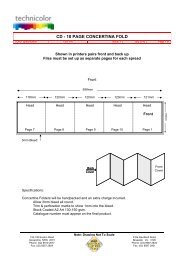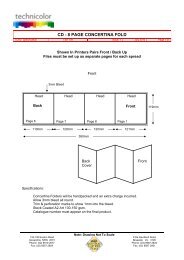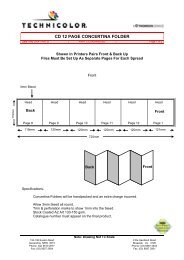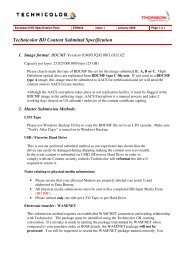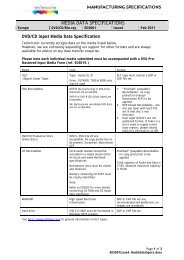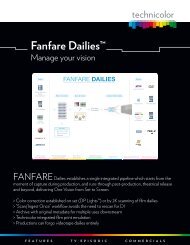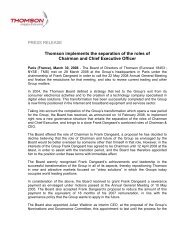FORM 20-F THOMSON multimedia - Technicolor
FORM 20-F THOMSON multimedia - Technicolor
FORM 20-F THOMSON multimedia - Technicolor
You also want an ePaper? Increase the reach of your titles
YUMPU automatically turns print PDFs into web optimized ePapers that Google loves.
anticipates a favorable currency exchange rate fluctuation, the corporate treasury department may<br />
leave a portion of our estimated exposure unhedged.<br />
Financial exposure. Our general policy is for subsidiaries to borrow and invest excess cash in<br />
the same currency as their functional currency. In certain developing countries with depreciating<br />
currencies we may, however, elect to maintain deposits in U.S. dollars or euro rather than the<br />
subsidiaries’ functional currency. These transactions are performed through the corporate treasury<br />
department to the extent practical. In order to balance the currencies that the corporate treasury<br />
department borrows (both internally and externally) with currencies that we lend to affiliates, we<br />
enter into currency swaps, unless local regulation makes it impossible. At December 31, <strong>20</strong>01, these<br />
swaps were primarily undertaken to swap euro deposited internally with our corporate treasury<br />
against U.S. dollars lent out by our corporate treasury department.<br />
Impact on Thomson. The majority of our net sales have traditionally been denominated in<br />
U.S. dollars. This reflects our strong presence in the United States, particularly with our Consumer<br />
Products division, and the important contribution of this division to our net sales. As a result, the<br />
fluctuations of the euro/U.S. dollar exchange rate have a significant translation impact on our net<br />
sales.<br />
Nevertheless, we believe that the impact of exchange rate fluctuations on our net income is<br />
limited due to certain natural hedges.<br />
) Our euro/U.S. dollar commercial exposure is reduced since most of the U.S. dollar sales<br />
generated by European subsidiaries (mainly Patents and Licensing) are offset by their<br />
U.S. dollar purchases in Asia (mainly finished products).<br />
) The euro/Japanese yen commercial exposure is also reduced since most of Japanese yen<br />
sales generated by European subsidiaries (mainly Patents and Licensing) are offset by their<br />
Japanese yen purchases in Asia (components and finished products).<br />
) Remaining net exposures are generally hedged with financial counterparts as described<br />
above.<br />
Interest Rate Fluctuations<br />
We are exposed to interest rate risk exposure through our deposits and indebtedness. In order<br />
to reduce this exposure, we enter into interest rate swaps and forward rate agreements.<br />
Our policy is for all subsidiaries to borrow from, and invest excess cash with, our corporate<br />
treasury department, which in turn satisfies its net cash needs by borrowing from external<br />
counterparts. Subsidiaries that are unable to enter into transactions with our corporate treasury<br />
department because of local laws or regulations borrow or invest directly with local banks under<br />
policies established by the corporate treasury department.<br />
The corporate treasury department manages our financing by applying established procedures,<br />
and it hedges interest rate risk exposure in accordance with target ratios of fixed to floating debt,<br />
which are set periodically as a function of market conditions.<br />
Because a portion of our debt and all of our deposits are at floating rates, changes in interest<br />
rates will impact our net interest expense. In <strong>20</strong>01, our average debt amounted to approximately<br />
0 1,148 million, 28% at floating rates taking into account interest rate hedging operations. Our<br />
average deposits in <strong>20</strong>01 amounted to approximately 0 1,121 million, 100% at floating rates. A 1%<br />
point variation in interest rates applied to the floating rate debt and deposits would have had an<br />
impact on our annual financial expenses of approximately 0 8.0 million. In <strong>20</strong>00 our average debt<br />
amounted to 0 583 million, 63% at floating rates taking into account interest rate hedging operations,<br />
and our average deposits amounted to 0 597 million, 100% at floating rates.<br />
98



